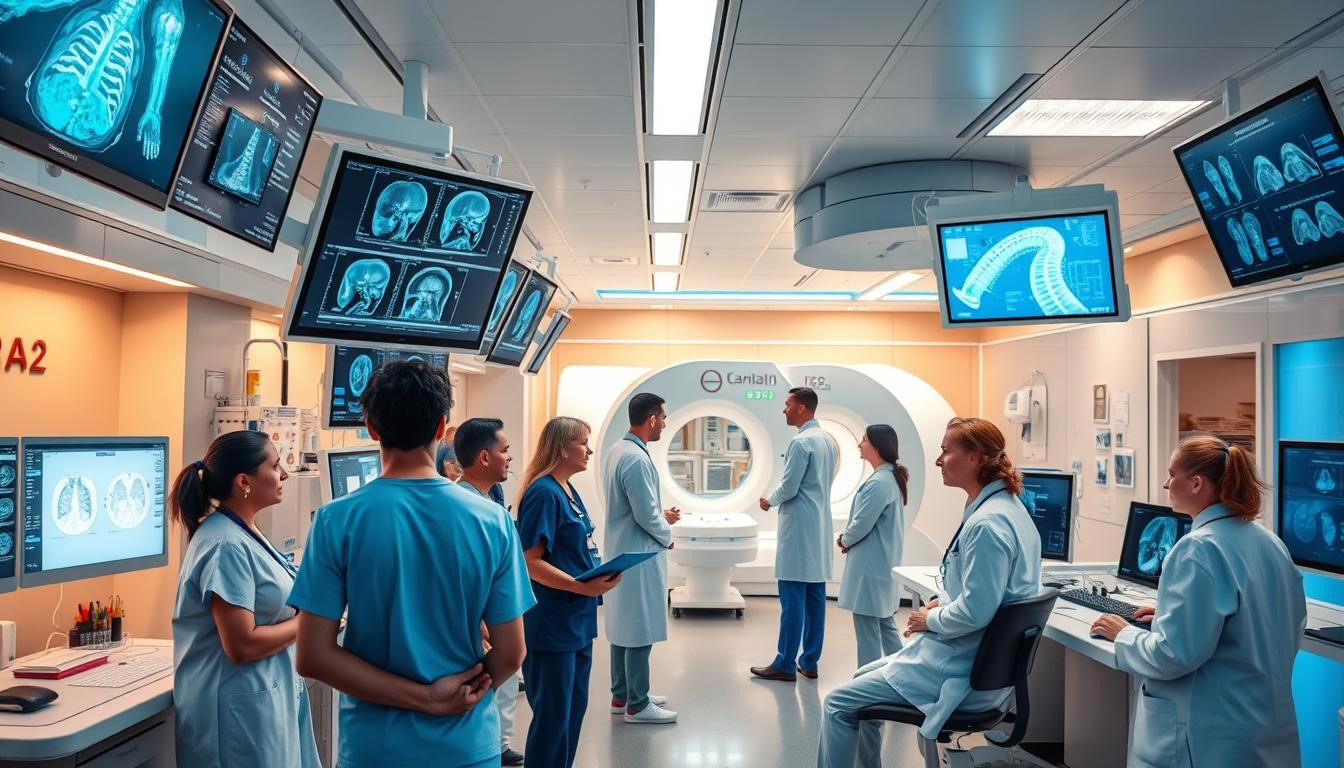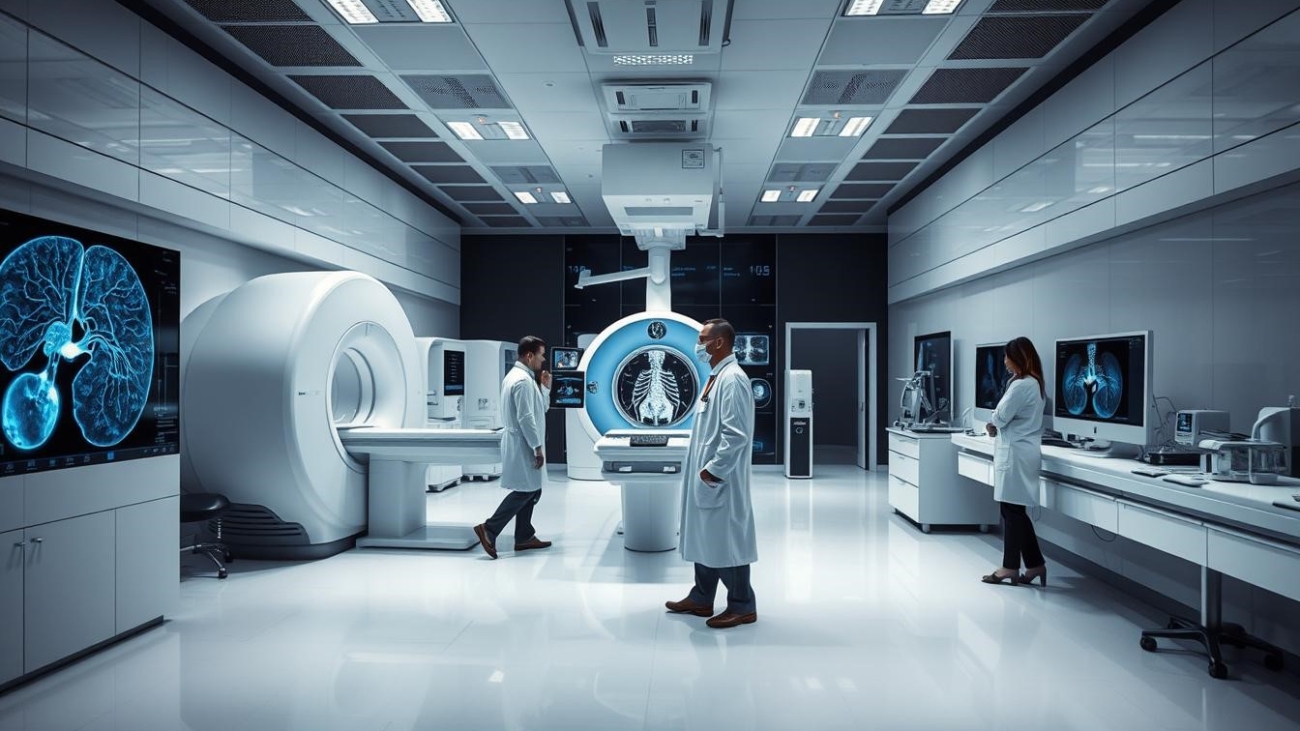In healthcare, Diagnostic Imaging is key for accurate diagnosis and treatment planning. There are many Imaging Modality options, each suited for different clinical questions. Medical Imaging Techniques have changed how healthcare professionals care for patients, helping them make better decisions.
From X-rays to advanced scanning technologies, each Imaging Modality has its own uses and benefits. Diagnostic Imaging lets healthcare professionals see inside the body, helping diagnose and treat many medical conditions. By picking the right Medical Imaging Techniques, healthcare professionals can ensure accurate diagnosis and better patient outcomes. This shows how important it is to know the different Imaging Modalities.

Understanding Different Imaging Modality Types
In Radiology, many Imaging Technologies are key for making decisions. It’s vital to know the different types. Each has its own strengths and uses, helping in diagnosis in unique ways.
Some main imaging types are:
- X-Ray and Radiography, which use ionizing radiation to produce images of internal structures
- CT Scanning Technologies, which provide detailed cross-sectional images using computer-processed combinations of many X-Ray measurements
- MRI Capabilities and Functions, which utilize magnetic fields and radio waves to generate images of organs and tissues
- Nuclear Medicine Imaging Options, which involve the use of small amounts of radioactive materials to diagnose and treat disease
- Ultrasound Applications, which employ high-frequency sound waves to create images of internal structures
These Imaging Technologies are crucial in Radiology. They help doctors make precise diagnoses and plan treatments. Knowing how each works helps improve patient care.
Key Factors in Clinical Image Selection
Healthcare providers look at several important factors when picking a diagnostic imaging method. They want to make sure it’s safe and effective. The type of condition being checked is a big factor. For example, X-rays and CT scans are good for bones and lungs. MRI is better for soft tissue injuries.
Another key factor is how easy it is for patients to get the imaging done. This includes the cost and where it’s available. The patient’s age, medical history, and physical ability also matter. The cost and where the imaging can be done are important too.
Some key things to think about when choosing an imaging method include:
- Patient-related factors, such as age and medical history
- System-related factors, like availability and cost of Diagnostic Imaging modalities
- Clinical question being addressed and the most suitable imaging modality
By thinking about these factors, healthcare providers can pick the best imaging method for each patient. This helps keep patients safe and makes healthcare more accessible.
Patient-Specific Considerations When Choosing Imaging Methods
When it comes to Medical Imaging Techniques, Patient Safety is a top priority. Imaging Technologies have evolved to meet various patient needs. But, certain factors can influence the choice of imaging modality. For instance, a patient’s age and medical history can significantly impact the selection of an appropriate imaging method.
Considering the patient’s overall health and medical background is crucial in determining the most suitable imaging technology. This includes evaluating the risks associated with Radiation Exposure and the potential reactions to Contrast Media. Additionally, physical limitations and mobility issues can also affect the imaging process, making it essential to choose a modality that accommodates these constraints.
Some key factors to consider when selecting an imaging modality include:
- Age and medical history: Certain imaging methods may be more suitable for patients with specific health conditions or age-related concerns.
- Radiation exposure: Minimizing radiation exposure is essential, especially for patients who require frequent imaging procedures.
- Contrast media considerations: Patients with certain medical conditions may be at risk of adverse reactions to contrast media, making alternative imaging methods necessary.
- Physical limitations and mobility issues: Imaging modalities that accommodate physical limitations, such as mobility issues or claustrophobia, can help ensure a comfortable and successful imaging process.
By taking these patient-specific factors into account, healthcare professionals can ensure that the chosen imaging method prioritizes Patient Safety. This while providing accurate diagnostic results through advanced Medical Imaging Techniques and Imaging Technologies.
Comparing Cost and Accessibility of Different Modalities
Choosing the right diagnostic imaging modality is key in Canada. The cost and how easy it is to get these services vary a lot. This affects how well patients can get the care they need.
Diagnostic Imaging is very important in healthcare. New technologies are always coming out. They offer new ways to diagnose and treat diseases.
The cost and how easy it is to get different imaging tests matter a lot. For example, an MRI scan costs more than an X-ray. This can affect what test a doctor chooses. Also, how long you have to wait and where you can get the test also play a big role.
- Canadian Healthcare Coverage Guidelines: Know what services are covered and what you might have to pay for.
- Wait Time Considerations: Things that affect how long you have to wait, like where you are and what tests are available.
- Regional Availability Factors: How different tests are available in different parts of Canada.
Thinking about these points helps healthcare providers and patients make better choices. They can pick the best imaging test, thinking about cost and how easy it is to get. This helps make sure patients get the care they need quickly and without breaking the bank. It also uses the latest in Imaging Technologies and Diagnostic Imaging.
Advanced Applications of Modern Imaging Techniques
Modern imaging techniques have changed radiology a lot. They help doctors diagnose and treat diseases better. In Canada, these new technologies are making healthcare better for everyone.
These techniques have led to new ways to see inside the body. Doctors can now use things like functional and molecular imaging. This helps them find and treat diseases like cancer and heart problems.
Imaging is also used to make treatment plans just for each patient. This makes care more personal and effective.
Some key areas where these techniques are used include:
- Cardiovascular imaging, which lets doctors see the heart and blood vessels clearly
- Cancer imaging, which helps find and treat tumors early
- Neuroimaging, which helps diagnose and treat brain diseases like stroke and Alzheimer’s
As imaging technology gets better, we’ll see even more new uses in radiology. These advancements are exciting for healthcare in Canada. They have the power to make care better for everyone.
Optimizing Diagnostic Accuracy Through Multi-Modal Approaches
Diagnostic Imaging is key in making clinical decisions. Using different imaging methods can greatly improve accuracy and safety. This way, doctors get a fuller picture of a patient’s health, leading to better care.
Multi-modal imaging offers a complete view of a patient’s health. For instance, MRI and CT scans together help spot complex issues more accurately. This method also cuts down on the need for extra tests, which means less radiation and lower costs.
- Combined imaging, where multiple modalities are used simultaneously to gather more detailed information
- Sequential imaging, where different modalities are used in a specific order to monitor a patient’s condition over time
- Integration with clinical findings, where imaging results are combined with other clinical data to provide a more comprehensive understanding of a patient’s condition
Healthcare teams use these methods to boost accuracy and safety. This leads to better care and a better life for patients. As Diagnostic Imaging grows, multi-modal approaches will become even more vital in making decisions.
Conclusion: Making Informed Imaging Decisions
Choosing the right imaging modality is key for accurate diagnosis and treatment planning. Healthcare providers must consider the different medical imaging techniques and their strengths. This ensures patients get the best diagnostic imaging for their needs.
We’ve looked at important factors for picking the right imaging modality. These include patient needs, cost, and how easy it is to get. Knowing the good and bad of each imaging method helps doctors make better choices. This leads to more accurate diagnoses and better health care.
The choice in diagnostic imaging needs a full view. It’s about meeting clinical needs, listening to patients, and using what’s available. Keeping up with new medical imaging techniques helps doctors give top-notch, personalized care. This improves patient results.
FAQ
What is the importance of selecting the appropriate imaging modality?
Picking the right imaging method is key for correct diagnosis and treatment planning. Each imaging technique is best for different questions. A personalized approach ensures patients get the best care.
What are the primary imaging modalities available?
Main imaging methods include X-Ray, Computed Tomography (CT), Magnetic Resonance Imaging (MRI), Nuclear Medicine, and Ultrasound. Each has its own tech and uses in healthcare.
What key factors influence the selection of an imaging modality?
Many things affect which imaging method to use. These include the patient’s health, age, and concerns about radiation. System factors like cost and where it’s available also play a role.
How do patient characteristics affect the choice of imaging method?
A patient’s age, health, and how they react to radiation are key. Their physical state also matters. Doctors must weigh these factors to choose the safest and most effective imaging.
What are the cost and accessibility considerations for different imaging modalities in the Canadian healthcare system?
In Canada, the cost and how easy it is to get imaging tests vary. This depends on what’s covered, wait times, and where it’s available. Knowing these helps ensure patients get the imaging they need.
What are some advanced and emerging applications of modern imaging techniques?
New imaging techs are making diagnostic imaging better. Doctors are using new methods to improve accuracy and care. This includes combining different imaging types and integrating them with clinical data.
How can the use of multi-modal imaging approaches improve diagnostic accuracy?
Using more than one imaging method at a time or in sequence helps. It gives more detailed info. This, along with clinical data, leads to better diagnoses and care for patients.


Add a Comment